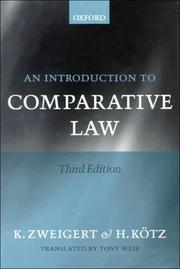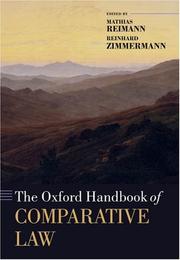| Listing 1 - 4 of 4 |
Sort by
|

ISBN: 9780198268598 0198268599 0198268602 Year: 1998 Publisher: Oxford Clarendon
Abstract | Keywords | Export | Availability | Bookmark
 Loading...
Loading...Choose an application
- Reference Manager
- EndNote
- RefWorks (Direct export to RefWorks)
The book first discusses the nature of Comparative Law, its functions, aims, methods and history, then it surveys the main features of the major legal families of the world.
Comparative law --- Contracts --- Droit comparé --- Contrats --- Comparative studies --- Etudes comparatives --- Civil law --- Droit civil --- 340.5 --- 340.2 --- Ba2 --- Law, Civil --- Private law --- Roman law --- Comparative jurisprudence --- Comparative legislation --- Jurisprudence, Comparative --- Law, Comparative --- Legislation, Comparative --- Rechtsvergelijking. Vergelijkend recht--(theorie) --- Civil law. --- Comparative law. --- 340.5 Rechtsvergelijking. Vergelijkend recht--(theorie) --- Droit comparé --- Droit comparé.

ISBN: 1841130680 9781841130682 Year: 2000 Publisher: Oxford Hart
Abstract | Keywords | Export | Availability | Bookmark
 Loading...
Loading...Choose an application
- Reference Manager
- EndNote
- RefWorks (Direct export to RefWorks)
Comparative law --- Law --- Civil law --- Common law --- 340.2 --- Ba2 --- -Law --- -Civil law --- Anglo-American law --- Law, Anglo-American --- Customary law --- Law, Civil --- Private law --- Roman law --- Acts, Legislative --- Enactments, Legislative --- Laws (Statutes) --- Legislative acts --- Legislative enactments --- Jurisprudence --- Legislation --- Civil law. --- Common law. --- Law - Europe
Book
ISBN: 3789043206 0421585609 9780421585607 Year: 1996 Publisher: London Sweet & Maxwell
Abstract | Keywords | Export | Availability | Bookmark
 Loading...
Loading...Choose an application
- Reference Manager
- EndNote
- RefWorks (Direct export to RefWorks)
Administrative law --- -342.4 --- Ba2.f --- Administration --- Law, Administrative --- Public administration --- Public law --- Constitutional law --- Law and legislation --- EEC / European Union - EU -Europese Unie - Union Européenne - UE --- 348.0 --- T11 Divers - Diversen --- Administratief recht : Algemene werken en handboeken. --- Administratief recht : Algemene werken en handboeken

ISBN: 9780199535453 9780199296064 0199296065 0199535450 Year: 2006 Publisher: Oxford Oxford University Press
Abstract | Keywords | Export | Availability | Bookmark
 Loading...
Loading...Choose an application
- Reference Manager
- EndNote
- RefWorks (Direct export to RefWorks)
The Oxford Handbook of Comparative Law provides a wide-ranging and highly diverse critical survey of comparative law at the beginning of the twenty-first century. It summarizes and evaluates a discipline that is time-honored but not easily understood in all its dimensions. In the current era of globalization, this discipline is more relevant than ever, both on the academic and on the practical level. The Handbook is divided into three main sections. Section I surveys how comparative law has developed and where it stands today in various parts of the world. This includes not only traditional model jurisdictions, such as France, Germany, and the United States, but also other regions like Eastern Europe, East Asia, and Latin America. Section II then discusses the major approaches to comparative law - its methods, goals, and its relationship with other fields, such as legal history, economics, and linguistics. Finally, Section III deals with the status of comparative studies in over a dozen subject matter areas, including the major categories of private, economic, public, and criminal law. The Handbook contains forty-three chapters which are written by experts from around the world. The aim of each chapter is to provide an accessible, original, and critical account of the current state of comparative law in its respective area which will help to shape the agenda in the years to come. Each chapter also includes a short bibliography referencing the definitive works in the field.
Comparative law --- Droit comparé --- Droit comparé --- 340.2 --- Ba2 --- Rechtsvergelijking. Vergelijkend recht--(theorie) --- 340.5 Rechtsvergelijking. Vergelijkend recht--(theorie) --- 340.5 --- Comparative jurisprudence --- Comparative legislation --- Jurisprudence, Comparative --- Law, Comparative --- Legislation, Comparative --- Legal theory and methods. Philosophy of law --- Comparative law. --- Pérou --- Mexique --- Bolivie --- France --- Allemagne --- Autriche --- Italie --- Royaume-Uni --- Etats-Unis --- Russie --- Pologne --- Hongrie --- Tchécoslovaquie --- Roumanie --- République tchèque --- Corée du Sud --- Japon --- Chine --- Chili --- Brésil --- Uruguay --- Espagne --- Portugal --- Argentine --- Sources et branches du droit
| Listing 1 - 4 of 4 |
Sort by
|

 Search
Search Feedback
Feedback About UniCat
About UniCat  Help
Help News
News